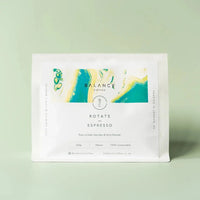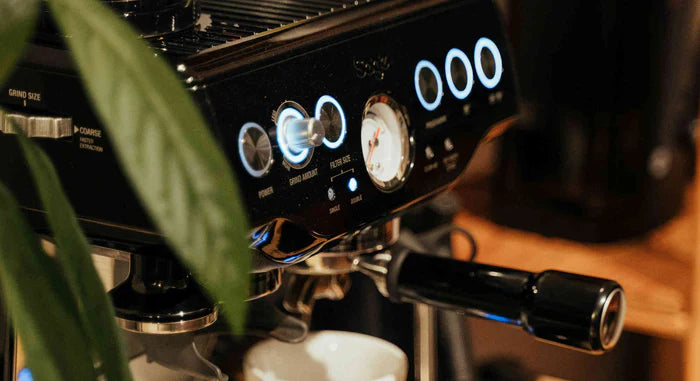Welcome to our comprehensive guide on how to make coffee with an Espresso Machine!
This guide is for you, whether you've just unboxed a shiny new espresso machine at home or you're looking to perfect your brewing technique.
We'll cover everything from setting up your machine, pulling the perfect shot, and making your favourite coffee drinks.
First, it’s important to note that making espresso is notoriously difficult to get right, especially at home without professional equipment or your personal barista to hand.
So, if you find it challenging, give yourself a break. Mastering the art of espresso takes some time, but once you do, you’ll be well on your way to making great espresso every time.
1. Unboxing and Setup
If you just received your shiny new espresso machine, then congratulations! Unboxing a new machine is always really exciting.
Carefully remove the machine and all accessories from the packaging. Check the manufacturer's manual to ensure all parts are included.
Placement
Choose a convenient, stable spot in your kitchen for the machine. Ensure it's near an electrical outlet and has enough space around it for ventilation.
Initial Cleaning
Wipe down all removable parts with a damp cloth. Rinse the water tank and fill it with fresh, filtered water.
If you didn't just unbox your new machine but are still here to get the best out of your existing espresso machine, do not worry; we have you covered, too.
2. Understanding Your Espresso Machine (The Very Basics)
Before you start brewing, it's essential to understand the key components of your espresso machine and the language used to describe each part:
Portafilter Handle
You place the ground coffee inside the portafilter handle and basket. This locks into the coffee machine and is removable after you've completed your espresso. It's the item you'll see me holding in the photo below 👇

Group Head
The part of the machine where the portafilter locks into and hot water is then dispensed from, pouring over the coffee.
Steam Wand
This is the espresso machine part you'll use for the frothing and steaming part when producing milk-based drinks.
Water Tank
Holds the water used for brewing and steaming. If you have a high-tech machine, it may be plumbed into your water supply directly.
Drip Tray
Catches any spills or overflow during brewing, serving as a sink for your espresso machine.
James' Expert Tip
Every espresso machine is unique. It is manufactured differently, with varying temperatures and steam pressures, producing different results.
After reading this blog, it's crucial to experiment with your machine to get the best out of it. This may also mean adjusting or buying a slightly different coffee grind to get the best flavour.
The machine you have may have limitations, so finding a specific machine guide for your make and model could also be helpful.
If you have a Sage coffee machine, you can read this blog to focus on your model after finishing with this article.
3. Coffee Grinder
A good grinder is crucial for making great coffee with your espresso machine. If your machine has a built-in grinder like the Sage Barista Pro, you're in luck. If not, you'll need a separate burr grinder.
If you need to upgrade because you're still buying pre-ground coffee, check out our coffee bean grinders.

Here's why a good quality grinder is so important:
Grind Size
The grind size significantly affects the flavour and quality of your espresso. Espresso requires a fine grind, similar to table salt which only high quality grinders are able to achieve to a precise level.
If your grinder is cheap, the grind sizes may vary between each coffee particle meaning you'll have inconsistency.
And to find the best grind size for any coffee you want, read this article here.
Consistency
It's best to buy or use a burr grinder because it ensures that you're working with a uniform grind size, which is essential for even extraction and balanced flavour.
If you haven't invested in a quality burr grinder, and if you're looking for a flavour upgrade, this is the step you need to take.
Steps for Grinding Coffee
Measure: Start with 18 grams of coffee beans for a double shot.
We only recommend producing double shots when making coffee because they produce higher-quality coffee than single shots.
Grind: Set your grinder to a fine espresso setting.

James' Expert Tip
You'll need to adjust the grind setting on your grinder/machine to optimise for better taste. It is important when learning how to make coffee with espresso machine.
This may initially feel confusing or scary, but it is vital to getting the best flavour out of our healthy speciality-grade beans.
4. Preparing Your Espresso Machine
Preparation is key to a smooth espresso brewing process. Here's what you need to do before brewing:
Heat Up
Turn on your machine and allow it to heat up. This can take 15 minutes to half an hour, depending on its power.
Warm the Portafilter and Cup: Run a blank shot (without coffee) to warm up the group head and Portafilter. Next, you can warm your cup by rinsing it with hot water. 
5. Choosing the Right Coffee Beans
The quality of your espresso starts with the beans (obviously). Here are some tips for selecting the best coffee:
Freshness
Always use fresh coffee beans, ideally within a month of roasting. If you're buying from us, we include a roast date on the bag so you can trust the freshness.
You'll also be able to notice the difference because of the incredible smell and flavour in the end cup.
Arabica Or Robusta
We prefer Arabica beans for their complexity of flavour, low bitterness, and maximum health advantages, including less caffeine jitteriness.
Roast Level
The rich, bold flavours of medium to darker roasts are ideal for espresso.
However, this is a generalisation, as you may prefer lighter, fruitier roasts that offer a unique flavour experience to experienced coffee drinkers.
James' Expert Tip
Think of coffee roasts like wine varieties. Medium to dark roast coffees are like rich, full-bodied red wines such as Cabernet Sauvignon.
They offer bold, straightforward flavours like chocolate and caramel, making them perfect for beginners thinking about how to make good coffee with espresso machine.

In contrast, light roasts are like delicate wines such as Pinot Noir or Sauvignon Blanc.
These coffees reveal subtle, complex notes of fruit and florals, which require a refined palate to appreciate.
Just as experienced wine drinkers enjoy the nuances of fine wines, seasoned coffee enthusiasts savour the more intricate flavours of light roast coffees.
6. Starting with the Espresso Recipe
You must perfect the espresso shot to make any drink on your machine, whether a flat white, an Americano, or a cappuccino.
Speaking of coffee drinks, I have previously written about the best coffee drinks in the world. You should read it.
Since it makes up at least 30% of your total beverage in terms of volume and provides the primary flavour, it's essential to focus on this step.
We also have additional resources to make Americano, flat white or Espresso.
Here we go:
Before you start brewing, decide on the recipe you want to follow. Based on my experience, here’s a basic guideline:
First, consider the size of your portafilter basket, which determines how much coffee your espresso machine can hold (this may vary depending on the machine you have).
Aim for 18 grams of freshly ground coffee to yield 36 grams of espresso.
This means that from the 18g of finely ground coffee you used in your basket, you should see 36 grams of liquid espresso in your cup after brewing.
James' Expert Tip
While measuring your coffee with scales might seem like extra effort, it’s essential for achieving the same quality and standard as you buy from an amazing café.
Just like baking a perfect cake, you might get lucky one time by guessing the ingredients, but it’s unlikely you’ll replicate it precisely. Consistency is key, and using scales ensures you can achieve that daily.

7. Dosing and Tamping
Dosing and tamping are critical steps in making espresso. They ensure even extraction and balanced flavour. Tamping also directly affects the espresso's 'body'.
Dosing: As mentioned above, you'll need to weigh out 18 grams of coffee and distribute it evenly in the portafilter basket.
For best accuracy, you'll need high-quality coffee scales, ideally to 0.1 of a gram reading.
Tamping: Use a tamper to press the coffee down with firm, even pressure. Aim for a level, compact puck.
James' Expert Tip
It can be frustrating when your coffee tastes amazing one day but awful, sour, or bitter the next. This inconsistency is often due to fluctuations in your brewing process.
As a barista, you must manage several variables, such as temperature, time, dose, tamping, weighing, and steaming.

Think of it as an ongoing craft you can gradually improve. Don’t get discouraged. The ultimate goal is consistency in your actions, leading to improved and more consistent great taste.
8. Pulling the Perfect Espresso Shot
Now for the exciting part—pulling your shot! Follow these steps for a perfect espresso:
Insert the Portafilter: Lock the portafilter into the group head. Start the Extraction: Begin the shot and watch the flow of coffee. It should start dark and thicken to a golden stream.

Your espresso machine may include a built-in timer so that you can monitor this.
Timing
A double shot should take 25-33 seconds. Adjust the grind size and tamping pressure if it’s too fast or slow.
James's Expert Tip
Coffee is unique and extremely volatile because it’s a natural product.
After roasting, coffee undergoes a process of de-gassing, which means its density changes based on atmospheric changes like heat and humidity.
Therefore, it's no surprise that it reacts slightly differently each day inside your grinder and with water, hence the need to make small adjustments often to ensure it aligns with our recipe.
If you've read our blog on coffee storage, you know that oxygen exposure also degrades the beans faster. These factors significantly impact the flavour.
I recommend treating each brewing session as if you're working with a brand-new product, adjusting meticulously to find that perfect flavour.
Espresso Summary
To summarise this section and before we move on to steaming milk, here's a video that provides a quick overview of all the details we've covered in case you'd like a video guide to support.
9. Milk Frothing and Steaming
I've spent hours teaching people how to make coffee with an espresso machine throughout the course of my coffee career, spanning 14+ years now.
Below, I share my top barista tips for steaming the perfect milk. Many espresso drinks require frothed or steamed milk, and here’s how to do it:
Purge the Steam Wand
Turn on the steam briefly to remove any water residue or excess dirt.
Position the Wand
Place the steam wand just below the surface of the milk (a cm or two.)
Froth
Turn on the steam wand dial on your machine to begin steaming. Slowly lower the pitcher as the milk starts to heat and noises occur.
Steam
Submerge the wand deeper to heat the milk. Aim for a maximum temperature of 60-65°C. If that's not hot enough, you can max out at around 68-70 °C before the milk begins to burn and negatively affect flavour.
Texture
Your milk should be smooth and velvety, with no large bubbles.
James' Expert Tip
To finish, first, tap the jug firmly on the counter to remove any bubbles on the surface of the milk.
This improves the texture and how the milk pours into and combines with the espresso.
Next, swirl the milk in circular motions while keeping the jug on the counter to re-combine the milk particles.
This step is crucial because milk separates quickly and loses its silky, velvety texture if not re-combined.
Now you're ready to pour, and it should look like this below. Enjoy!
10. Experimenting with Different Coffee Flavours & Mushrooms
Experimenting with flavours lets you get creative and find what you love best.
Different Beans: Try beans with different roast profiles to find your perfect match.
Brew Ratios: Adjust the coffee-to-water ratio to tweak strength and flavour based on your liking.
Add Mushrooms: For an extra health boost, add our mushroom elixirs like Lion’s Mane or Cordyceps to your coffee. These adaptogens can enhance focus and energy without the jitters.
James' Expert Tip
While this guide provides a solid foundation, each coffee is unique. Taste test regularly to find the best results that work for you.
Once you've mastered the art of espresso making, consider upgrading your routine with our mushroom tincture elixirs.

Adding Lion’s Mane or Cordyceps can boost your focus and energy, enhancing your overall wellness without the coffee jitters.
Chaga is for immunity and defence, and Reishi helps calm the nervous system and improve sleep quality.
11. How to Make Your Favourite Coffee Drinks (Recipes)
Here are recipes for popular coffee drinks using your espresso machine: Espresso: Brew a double shot using 18 grams of freshly ground coffee to 38 grams of espresso.
Americano
First, add 120 ml of hot water to your cup (depending on its size). Then, pour a double shot of espresso directly on top.
This method is crucial so you don't burn the coffee with hot water, thus preserving flavour.
Latte
Pull a double shot of espresso. Add steamed milk and a small amount of foam.
Also, read my article on the best coffee beans for Latte. Some of the brands on there are pretty interesting.
Cappuccino
Pull a double shot of espresso. Add equal parts steamed milk and foam.
Here is an article to help you find the best coffee beans for a cappuccino. It is worth the read.
Flat White
Pull a double shot of espresso. Add steamed milk with a thin layer of foam.

Cortado
Pull a double shot of espresso. Add an equal amount of steamed milk.
James' Expert Tip
Experiment with different milk types and temperatures to find your preferred taste and texture.
For an extra health boost, mix in our mushroom elixirs, like Lion’s Mane or Cordyceps, to enhance focus and energy.
Each cup of coffee is an opportunity to refine your brewing skills and discover new flavours. Enjoy the process and savour each sip!
12. Troubleshooting Common Issues
Every barista, novice or experienced, faces challenges. Here are solutions to common issues:
Sour Espresso
The shot is under-extracted. Try a finer grind and ensure proper tamping.
Bitter Espresso
The shot is over-extracted. Use a coarser grind and reduce the extraction time.
Weak Espresso
Increase the dose or use a finer grind to boost strength.
No Crema
Ensure your beans are fresh, and try a finer grind.
Conclusion
So there you have it, how to make coffee with an espresso machine.
Making the perfect espresso takes practice and patience.
But with these tips and tricks from my barista, you'll be well on your way to mastering your espresso machine.
Enjoy experimenting with different beans, recipes, and techniques to find your perfect cup.
And I'll be so pleased if you join me in adding mushrooms to your coffee for an upgraded approach to health.
Happy brewing, Balance family.














